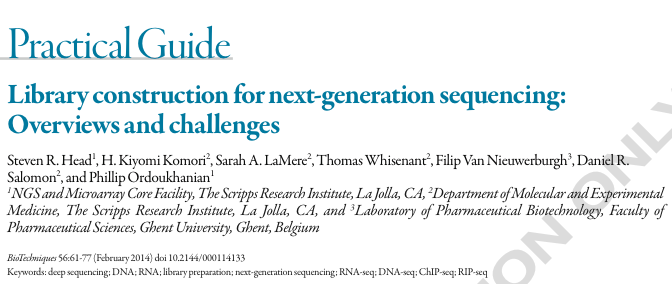A recent BioTechniues practical guide: Libraryconstruction for next-generation sequencing: Overviews and challenges, written by Steven Head et al from the The ScrippsResearch Institute NGS and Microarray Core Facility; might be just the thing to hand out to your NGS newbies as it covers pretty much every aspect of library they need to know!
The focus is very much on the options and challenges users face when making decisions about how to make NGS libraries. The article has sections on fragmentation; DNA library prep; RNA-seq library prep; complexity, bias and batch effects; target capture/amplification; mate-pair library prep; ChIP-seq library prep; RIP-seq/CLIP-seq and finally Methylation sequencing.
DNA fragmentation: This section covers all the major options, physical or enzymatic and discusses the importance of making sure the insert size is correct for your application. An interesting comment was that the lab has successfully clustered and sequenced libraries with 1500bp inserts!
Complexity, bias, and batch effects: The section discusses the importance of understanding the biases in the methods being used and of good experimental design. The use of duplicate reads to measure library complexity covers the important points of read-depth and sampling error. And the authors present the basic methods as applied to genomes where nucleic acids are present in roughly equimolar ratios; and discuss the caveats of applying the same methods to RNA-seq or ChIP-seq, where they most certainly are not. There is only a brief mention of molecular indexing and the potential impact this has on NGS analysis. The first take home message is to minimise batch effects and PCR – but there is no discussion about the quantification of your final libraries being a good place to make decisions on reducing PCR cycles. The second is that user should “keep in mind the general principle that more starting material means less amplification and thus [usually] better library complexity”, just because a kit can work with 50ng or RNA does not mean you should use 50ng when you can easily get 500ng!
Target capture/amplification: This section covers the major methods for in-solution target capture. But it is a bit light on amplicon sequencing methods, there are many companies out there selling amplicon kits and I’d suggest people look at the Fluidigm Access Array and Wafergen SmartChip for amplicons on Illumina, or even combine Ampliseq with Nextera XT.
Single-cells: The review only briefly mentions single cells and the Fluidigm C1 system. I suspect we will not have long to wait before we start to see similar papers focused on single-cell NGS.
DNA fragmentation: This section covers all the major options, physical or enzymatic and discusses the importance of making sure the insert size is correct for your application. An interesting comment was that the lab has successfully clustered and sequenced libraries with 1500bp inserts!
Complexity, bias, and batch effects: The section discusses the importance of understanding the biases in the methods being used and of good experimental design. The use of duplicate reads to measure library complexity covers the important points of read-depth and sampling error. And the authors present the basic methods as applied to genomes where nucleic acids are present in roughly equimolar ratios; and discuss the caveats of applying the same methods to RNA-seq or ChIP-seq, where they most certainly are not. There is only a brief mention of molecular indexing and the potential impact this has on NGS analysis. The first take home message is to minimise batch effects and PCR – but there is no discussion about the quantification of your final libraries being a good place to make decisions on reducing PCR cycles. The second is that user should “keep in mind the general principle that more starting material means less amplification and thus [usually] better library complexity”, just because a kit can work with 50ng or RNA does not mean you should use 50ng when you can easily get 500ng!
Target capture/amplification: This section covers the major methods for in-solution target capture. But it is a bit light on amplicon sequencing methods, there are many companies out there selling amplicon kits and I’d suggest people look at the Fluidigm Access Array and Wafergen SmartChip for amplicons on Illumina, or even combine Ampliseq with Nextera XT.
Single-cells: The review only briefly mentions single cells and the Fluidigm C1 system. I suspect we will not have long to wait before we start to see similar papers focused on single-cell NGS.
“When in doubt, consulting a statistician during the experimental design process can save an enormous amount of wasted money and time.”

No comments:
Post a Comment
Note: only a member of this blog may post a comment.